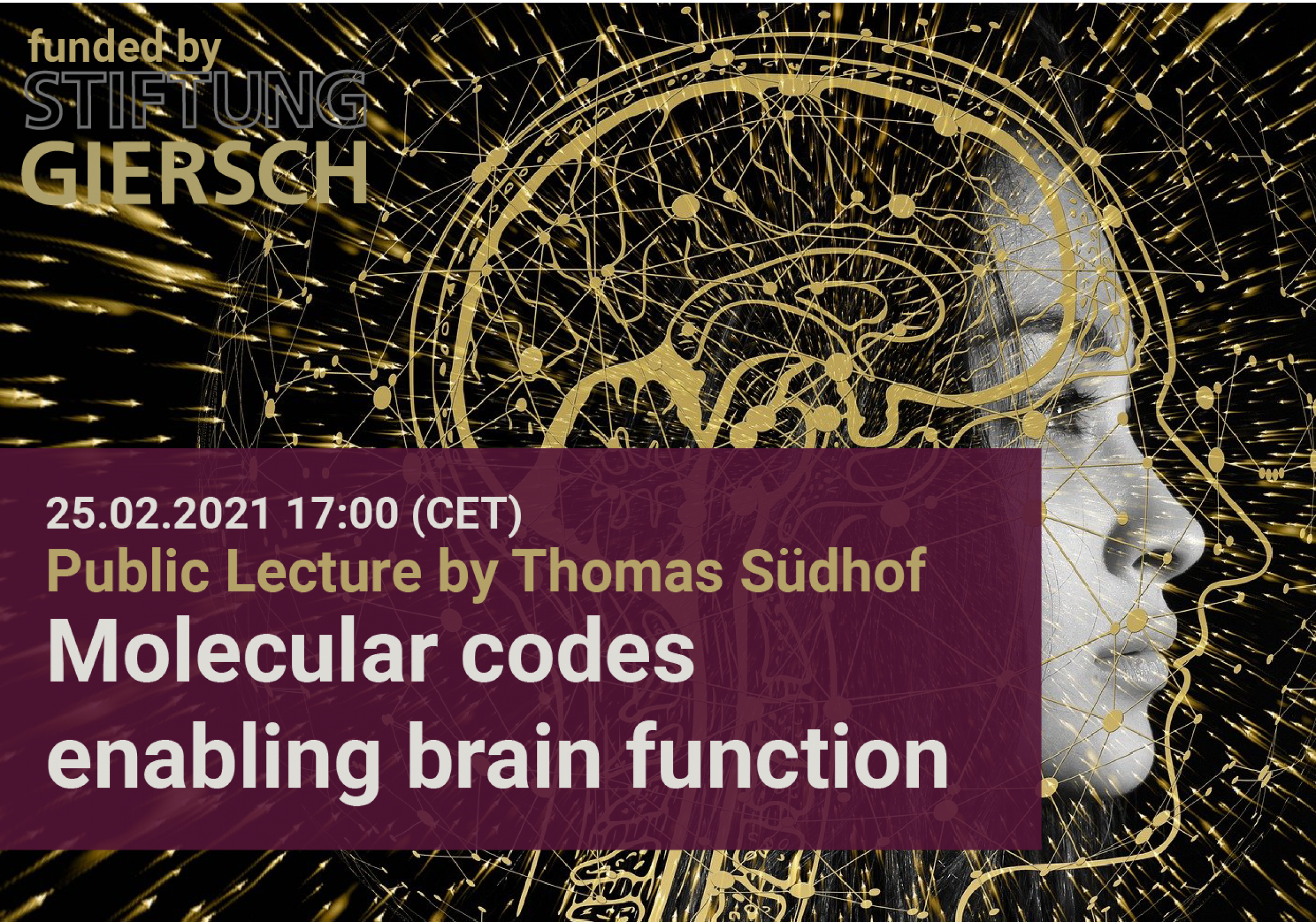February 25, 2021 5:00 PM / Everyone
Molecular codes enabling brain function
by Thomas Südhof, Stanford University, USA

Venue: online
For a person to think, act, or feel, the neurons in a person’s brain must communicate continuously, rapidly, and repeatedly. This communication occurs at synapses, specialized junctions between neurons that transfer and compute information on a millisecond timescale. By forming synapses with each other, neurons are organized into vast overlapping neural circuits. As intercellular junctions, synapses are asymmetric with a presynaptic terminal that emits a transmitter signal and a postsynaptic cell that receives this signal. Synapses differ in properties and exhibit distinct types of plasticity, enabling fast information processing as well as learning and memory. Synapses are the most vulnerable component of the brain whose dysfunction initiates multifarious brain disorders. Despite their importance, however, synapses are poorly understood beyond basic principles. Thomas Südhof’s laboratory studies how synapses form in the brain and how their properties are specified, which together organize neural circuits. Moreover, the Südhof laboratory examines how synapses become dysfunctional in neurodegenerative and neuropsychiatric disorders to pave the way for better therapies.
The Speaker
Thomas Christian Südhof was born in Göttingen, Germany in 1955 and obtained his M.D. and doctoral degrees from the University of Göttingen in 1982. He performed his doctoral thesis work at the Max-Planck-Institut für biophysikalische Chemie in Göttingen with Prof. Victor P. Whittaker on the biophysical structure of secretory granules. From 1983-1986, Südhof trained as a postdoctoral fellow with Drs. Mike Brown and Joe Goldstein at UT Southwestern in Dallas, TX, and elucidated the structure, expression and cholesterol-dependent regulation of the LDL receptor gene. Südhof began his independent career in 1986 at UT Southwestern, where he stayed until 2008 and, among others, was the founding chair of the Department of Neuroscience. In 2008, Südhof moved to Stanford, and became the Avram Goldstein Professor in the School of Medicine at Stanford University. In addition, Südhof has been an Investigator of the Howard Hughes Medical Institute since 1986.
Prior to becoming a neuroscientist, Südhof was trained in the biophysics of subcellular organelles at the Max-Planck-Institute of Biophysical Chemistry and in cholesterol metabolism at UT Southwestern. When Südhof started his laboratory, he decided to switch to neuroscience to study synapses because of their central, as yet incompletely understood role in brain function. Südhof’s work initially focused on the mechanism of neurotransmitter release, which is the first step in synaptic transmission that accounts for the speed and precision of information transfer in the brain. It was for this work that Südhof was awarded in 2013 the Albert Lasker Basic Medical Research Award (with Richard Scheller) and the Nobel Prize in Physiology or Medicine (with James Rothman and Randy Schekman). In the last decade, Südhof’s research emphasis has switched to focus on a different unsolved problem in neuroscience that regards synapses, namely how synapses are established specifically between defined pre- and postsynaptic neurons, and how such connections are endowed with specific properties by these neurons. Addressing this fundamental question is essential for understanding how circuits are wired and how they process information, but the basic rules that govern synapse formation and specification are only now beginning to emerge. Elucidating these rules is the goal of Südhof’s present work.
The Lecture Series:
In the line of the Giersch – Summer School & International Conference on “Theoretical and Experimental Quantitative Cell Biology”. Interested people from all over the world are invited to join the series of public lectures live broadcasted from the 22. of February to the 4th of March 2021. Designated experts give insights in their research work and visions on future developments. The public lectures are part of the Giersch Summer School & Conference funded by the Giersch Foundation and FIAS and the scientific networks LOEWE DynaMem, LOEWE CMMS, ‘Xidian-FIAS Joint Research Center’ (XF-JRC), the Rhein-Main Universities, and the graduate program GRADE – IQbio.